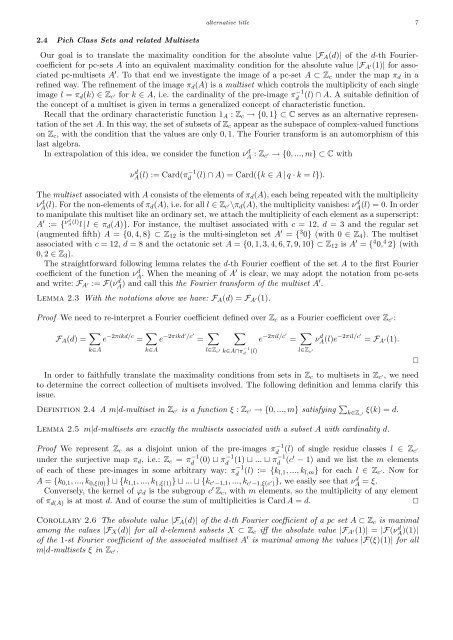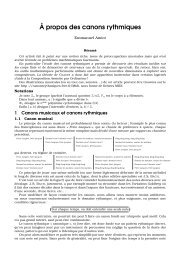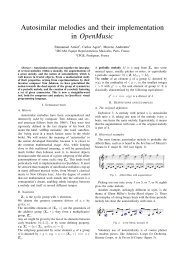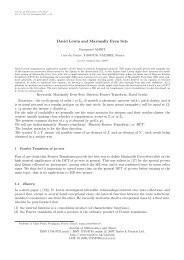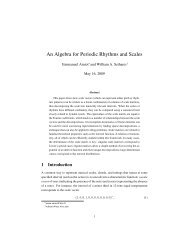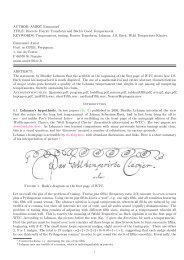Emmanuel Amiot Modèles algébriques et algorithmes pour la ...
Emmanuel Amiot Modèles algébriques et algorithmes pour la ...
Emmanuel Amiot Modèles algébriques et algorithmes pour la ...
You also want an ePaper? Increase the reach of your titles
YUMPU automatically turns print PDFs into web optimized ePapers that Google loves.
2.4 Pich C<strong>la</strong>ss S<strong>et</strong>s and re<strong>la</strong>ted Multis<strong>et</strong>s<br />
alternative title 7<br />
Our goal is to trans<strong>la</strong>te the maximality condition for the absolute value |FA(d)| of the d-th Fouriercoefficient<br />
for pc-s<strong>et</strong>s A into an equivalent maximality condition for the absolute value |FA ′(1)| for associated<br />
pc-multis<strong>et</strong>s A ′ . To that end we investigate the image of a pc-s<strong>et</strong> A ⊂ Zc under the map πd in a<br />
refined way. The refinement of the image πd(A) is a multis<strong>et</strong> which controls the multiplicity of each single<br />
image l = πd(k) ∈ Zc ′ for k ∈ A, i.e. the cardinality of the pre-image π−1<br />
d (l) ∩ A. A suitable definition of<br />
the concept of a multis<strong>et</strong> is given in terms a generalized concept of characteristic function.<br />
Recall that the ordinary characteristic function 1A : Zc → {0, 1} ⊂ C serves as an alternative representation<br />
of the s<strong>et</strong> A. In this way, the s<strong>et</strong> of subs<strong>et</strong>s of Zc appear as the subspace of complex-valued functions<br />
on Zc, with the condition that the values are only 0, 1. The Fourier transform is an automorphism of this<br />
<strong>la</strong>st algebra.<br />
In extrapo<strong>la</strong>tion of this idea, we consider the function νd A : Zc ′ → {0, ..., m} ⊂ C with<br />
ν d A(l) := Card(π −1<br />
d (l) ∩ A) = Card({k ∈ A | q · k = l}).<br />
The multis<strong>et</strong> associated with A consists of the elements of πd(A), each being repeated with the multiplicity<br />
νd A (l). For the non-elements of πd(A), i.e. for all l ∈ Zc ′\πd(A), the multiplicity vanishes: νd A (l) = 0. In order<br />
to manipu<strong>la</strong>te this multis<strong>et</strong> like an ordinary s<strong>et</strong>, we attach the multiplicity of each element as a superscript:<br />
A ′ := { νd A (l) l | l ∈ πd(A)}. For instance, the multis<strong>et</strong> associated with c = 12, d = 3 and the regu<strong>la</strong>r s<strong>et</strong><br />
(augmented fifth) A = {0, 4, 8} ⊂ Z12 is the multi-singl<strong>et</strong>on s<strong>et</strong> A ′ = { 3 0} (with 0 ∈ Z4). The multis<strong>et</strong><br />
associated with c = 12, d = 8 and the octatonic s<strong>et</strong> A = {0, 1, 3, 4, 6, 7, 9, 10} ⊂ Z12 is A ′ = { 4 0, 4 2} (with<br />
0, 2 ∈ Z3).<br />
The straightforward following lemma re<strong>la</strong>tes the d-th Fourier coeffient of the s<strong>et</strong> A to the first Fourier<br />
coefficient of the function ν d A . When the meaning of A′ is clear, we may adopt the notation from pc-s<strong>et</strong>s<br />
and write: FA ′ := F(νd A ) and call this the Fourier transform of the multis<strong>et</strong> A′ .<br />
Lemma 2.3 With the notations above we have: FA(d) = FA ′(1).<br />
Proof We need to re-interpr<strong>et</strong> a Fourier coefficient defined over Zc as a Fourier coefficient over Zc ′:<br />
FA(d) = <br />
e −2πikd/c = <br />
e −2πikd′ /c ′<br />
= <br />
k∈A<br />
k∈A<br />
l∈Z c ′<br />
<br />
k∈A∩π −1<br />
d (l)<br />
e −2πil/c′<br />
= <br />
ν d A(l)e −2πil/c′<br />
= FA ′(1).<br />
In order to faithfully trans<strong>la</strong>te the maximality conditions from s<strong>et</strong>s in Zc to multis<strong>et</strong>s in Zc ′, we need<br />
to d<strong>et</strong>ermine the correct collection of multis<strong>et</strong>s involved. The following definition and lemma c<strong>la</strong>rify this<br />
issue.<br />
<br />
Definition 2.4 A m|d-multis<strong>et</strong> in Zc ′ is a function ξ : Zc ′ → {0, ..., m} satisfying k∈Z ξ(k) = d.<br />
c ′<br />
Lemma 2.5 m|d-multis<strong>et</strong>s are exactly the multis<strong>et</strong>s associated with a subs<strong>et</strong> A with cardinality d.<br />
Proof We represent Zc as a disjoint union of the pre-images π −1<br />
d (l) of single residue c<strong>la</strong>sses l ∈ Zc ′<br />
under the surjective map πd, i.e.: Zc = π −1<br />
d (0) ⊔ π−1<br />
d (1) ⊔ ... ⊔ π−1<br />
d (c′ − 1) and we list the m elements<br />
of each of these pre-images in some arbitrary way: π −1<br />
d (l) := {kl,1, ..., kl,m} for each l ∈ Zc ′. Now for<br />
A = {k0,1, ..., k0,ξ(0)} ⊔ {k1,1, ..., k1,ξ(1)} ⊔ ... ⊔ {kc ′ −1,1, ..., kc ′ −1,ξ(c ′ )}, we easily see that νd A = ξ.<br />
Conversely, the kernel of ϕd is the subgroup c ′ Zc, with m elements, so the multiplicity of any element<br />
of πd(A) is at most d. And of course the sum of multiplicities is Card A = d. <br />
Corol<strong>la</strong>ry 2.6 The absolute value |FA(d)| of the d-th Fourier coefficient of a pc s<strong>et</strong> A ⊂ Zc is maximal<br />
among the values |FX(d)| for all d-element subs<strong>et</strong>s X ⊂ Zc iff the absolute value |FA ′(1)| = |F(νd A )(1)|<br />
of the 1-st Fourier coefficient of the associated multis<strong>et</strong> A ′ is maximal among the values |F(ξ)(1)| for all<br />
m|d-multis<strong>et</strong>s ξ in Zc ′.<br />
l∈Z c ′


